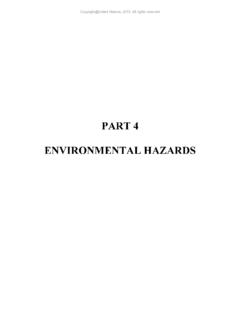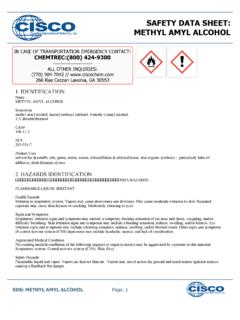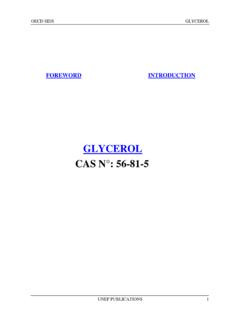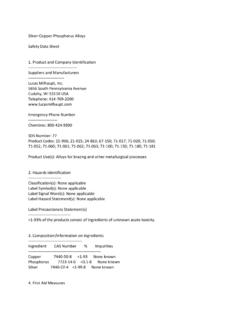Transcription of An evaluation of the Ceriodaphnia dubiachronic toxicity ...
1 Margaret Passmore, Amy Bergdale, Greg Pond, Louis Reynolds, Kelly Krock and Frank Borsuk US EPA R3, Wheeling, WVAn evaluation of the Ceriodaphnia dubiachronic toxicity test as an indicator of instream effects from mountaintop coal miningJones BranchMiddle Fork WatershedMartin Co., KYBackground Alkaline coal mining effluent Elevated Total Dissolved Solids (dominated by Ca2+, Mg2+, HCO3- and SO42-), Fe, Mn, Ni, Zn, Se and NO3- Mined streams have increased base flow Adverse effects to water quality and benthic macroinvertebratesBackground NPDES permit limits require pH, Fe and TSS Some WQBELs for Mn, Al, Se No limits for TDS/conductivity/ions Whole Effluent toxicity (WET) testing has been proposed for NPDES permits Would WET protect native biota?Objectives What level of water quality degradation is associated with lethal or sublethal effects to C. dubia? What s causing the observed toxicity ?
2 How do WET results compare to macroinvertebrate results? Can C. dubiachronic tests indicate instream aquatic life condition? Site Criteria Central Appalachians Headwater streams downstream valley fills pH circum neutral or alkaline Cond > 1000 uS/cm Sampling reach upstream of residences Impaired aquatic life Physical habitat sufficient 18 headwater streams, 1 pond, 1 ditch 1 VA, 7 KY, 12 WVSite LocationsMethods WVDEP macroinvertebrates WVSCI, genus level metrics All sites impaired for macroinvertebrates RPB habitat C. dubia 7-day chronic testing IC25: dilution that resulted in a 25% decrease in reproduction compared to control IC25 > 100%, no toxicity ; as IC25 decreases, more toxicity Field and lab chems Ion toxicity Model (Mount et al 1997): Acute 48-hr mortality, relative measure of ion toxicityK+ > HCO3- = Mg2+ > Cl- > SO42-Habitat not a confounding factor:UNT to Cow CreekIsland Creek watershedLogan Co.
3 , WVRBP 165 Optimal Habitat a slight confoundingfactor:Upper Dempsey BranchPigeon Creek WatershedLogan Co., WVRBP 146 Marginal to suboptimalHabitat a severeconfoundingFactor? Severe mineral precipitation caused by poor water Leatherwood CreekLeatherwood CreekClay Co., WVRBP 111 Marginal - poorMineral precipitation on substratesUNT Leatherwood CreekWVA single Hydropsychewas dubiaResults Lethal and sublethal toxicity at 2 sites Sublethal toxicity at 15 sites No toxicity at 3 sites (IC25 > 100%) Mean IC25 of toxic samples was 21% Conductivity of ambient sample was a good predictor of toxicityConductivity and IC 25R 2= Cond. Of Ambient Sample (uS/cm)IC25 ReproductionIncreasing Toxicity05001000150020002500 Lab Conductivity100%Hardness ( )Sulfate (mg/l)No reproductive effectReproductive effect050100150200250 Calcium (mg/l)Magnesium (mg/l)Potassium (mg/l)Nickel (ug/l)Conductivity, hardness, calcium, magnesium, potassium, nickel and sulfate were significantly higher in sites that exhibited reproductive effects (n=17) compared to those that did not (n=3).
4 All [Metals] < Chemical Means @ IC 25 Potential Toxicants 546 S/cm conductivity 203 mg/l sulfate 108 mg/l HCO3- alkalinity 35 mg/l magnesium 3 mg/l potassium g/l nickel Potential Ameliorating Factors 291 mg/l hardness 59 mg/l calciumObserved and Predicted dubia mortality (observed)48 hr mortality (predicted) 7 day observed mortality48 hr observed mortalityThe solid line indicatescomplete agreementbetween 48 hr and 7 IC25 and Predicted dubia IC25 Reproduction (observed)C. dubia 48 hr survival (predicted)mortality lowrepro highmortality medrepro highmortality lowrepro medmortality lowrepro lowIncreasing ToxicityIncreasing ToxicityConclusions 17 of 20 sites toxic Effect is chronic and sublethal Ions are causing some toxicity Metals < chronic criteria Additional toxicants present at some sites? Conductivity correlated well to toxicityConclusions C. dubiamore tolerant than natives Habitat confounding at some sites WET will not fully protect aquatic life, but WET tests and TIEs still a good idea Instream biomonitoring also needed to: fully protect aquatic life evaluate success of permits







